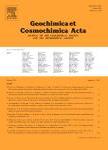版权所有:内蒙古大学图书馆 技术提供:维普资讯• 智图
内蒙古自治区呼和浩特市赛罕区大学西街235号 邮编: 010021

作者机构:OREGON STATE UNIVDEPT GEOLCORVALLISOR 97331
出 版 物:《GEOCHIMICA ET COSMOCHIMICA ACTA》 (地球化学与宇宙化学学报)
年 卷 期:1978年第42卷第NA6期
页 面:789-800页
核心收录:
学科分类:0709[理学-地质学] 081803[工学-地质工程] 07[理学] 08[工学] 0708[理学-地球物理学] 0818[工学-地质资源与地质工程]
基 金:National Science Foundation NSF (DES74-08935)
摘 要:Consideration of experimental data on the distribution of Mg2+ between olivine and silicate liquid clearly demonstrates that the distribution coefficient (KMg ) is dependent upon variations in temperature, pressure and melt composition, largely because these variables control the solubility of Mg2+ in the melt phase. Attempts to minimize composition dependence of KMg , utilizing various activity-composition models for silicate melts, have been partially successful. Composition-related effects do not appear to be large, however, for melts of restricted range in composition (e.g., tholeiitic or lunar basalts) as long as the contents of alkalis and the alkali/alumina ratio are relatively small (on a molar basis). For such melts, KMg may be used as a reliable geothermometer. By analogy, these conclusions can be extended to the distribution of other divalent cation such as Fe2+ , Mn2+ , Ni2+ and Co2+ .